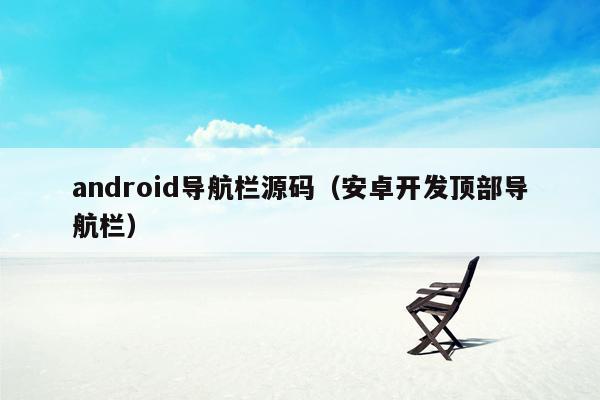android导航栏源码(安卓开发顶部导航栏)
本文目录一览:
- 1、android底部导航栏怎么做,
- 2、如何控制android系统中NavigationBar 的显示与隐藏
- 3、如何实现Android透明导航栏
- 4、Android 顶部导航栏
- 5、Android 目前最流行的 底部导航栏 用什么做的
- 6、android 怎么实现左侧导航栏
android底部导航栏怎么做,
可以使用radiogroup做底部导航
radiogroup的属性自定义,并设置android:button="@null"
?xml version="1.0" encoding="utf-8"?
LinearLayout xmlns:android=""
android:layout_width="fill_parent"
android:layout_height="60dip"
android:background="@drawable/bottom_bg"
android:orientation="horizontal"
RadioGroup
android:layout_width="fill_parent"
android:layout_height="match_parent"
android:orientation="horizontal"
RadioButton
style="@style/navigation_bottom_radio"
android:drawableTop="@drawable/bottom_home_d"
android:text="@string/home_tv" /
RadioButton
style="@style/navigation_bottom_radio"
android:drawableTop="@drawable/bottom_looks_d"
android:text="@string/style_tv" /
RadioButton
style="@style/navigation_bottom_radio"
android:drawableTop="@drawable/bottom_cam"
android:gravity="center"
android:text="拍照"
/
RadioButton
style="@style/navigation_bottom_radio"
android:drawableTop="@drawable/bottom_shopping_d"
android:text="@string/shopping_tv" /
RadioButton
style="@style/navigation_bottom_radio"
android:drawableTop="@drawable/bottom_show_d"
android:text="@string/show_tv" /
/RadioGroup
/LinearLayout
resources
style name="navigation_bottom_radio"
!-- 内部组件的排列 --
item name="android:gravity"center_horizontal/item
!-- 背景样式 --
item name="android:background"@drawable/style_navigation_radio/item
!-- 宽度 --
item name="android:layout_width"fill_parent/item
!-- 高度 --
item name="android:layout_height"wrap_content/item
!-- 设置RadioButton的原来图片为空 --
item name="android:button"@null/item
!-- 与其他组件宽度占相同比重 --
item name="android:layout_weight"1.0/item
!-- 底部的空隙 --
item name="android:paddingBottom"2.0dip/item
!-- 顶部的空隙 --
item name="android:paddingTop"2.0dip/item
!-- 文字的大小 --
item name="android:textSize"11dip/item
!-- 文字的颜色 --
item name="android:textColor"@color/white/item
/style
/resources
参考:
如何控制android系统中NavigationBar 的显示与隐藏
我们使用的大多数android手机上的Home键,返回键以及menu键都是实体触摸感应按键。如果你用Google的Nexus4或Nexus5话,你会发现它们并没有实体按键或触摸感应按键,取而代之的是在屏幕的下方加了一个小黑条,在这个黑条上有3个按钮控件,这种设置无疑使得手机的外观的设计更加简约。但我遇到身边用Nexus 4手机的人都吐槽这种设计,原因很简单:好端端的屏幕,被划出一块区域用来显示3个按钮(如下图所示):Back, Home, Recent。并且它一直用在那里占用着。
在android源码中,那一块区域被叫做NavigationBar。同时,google在代码中也预留了标志,用来控制它的显示与隐藏。NavigationBar的显示与隐藏的控制是放在SystemU中的,具体的路径是:\frameworks\base\packages\SystemUI。对android4.0以上的手机而言,SystemUi包含两部分:StatusBar和NavigationBar。在SystemUI的工程下有一个类PhoneStatusBar.java,在该类中可以发现关于控制NavigationBar的相关代码:
在start()方法里可以看到NavigationBar是在那时候被添加进来,但只是添加,决定它显示还是隐藏是在后面控制的。
span style="font-size:18px;"@Override
public void start() {
mDisplay = ((WindowManager)mContext.getSystemService(Context.WINDOW_SERVICE))
.getDefaultDisplay();
updateDisplaySize();
/// M: Support Smartbook Feature.
if (SIMHelper.isMediatekSmartBookSupport()) {
/// M: [ALPS01097705] Query the plug-in state as soon as possible.
mIsDisplayDevice = SIMHelper.isSmartBookPluggedIn(mContext);
Log.v(TAG, "start, mIsDisplayDevice=" + mIsDisplayDevice);
}
super.start(); // calls createAndAddWindows()
addNavigationBar();
// Lastly, call to the icon policy to install/update all the icons.
mIconPolicy = new PhoneStatusBarPolicy(mContext);
mHeadsUpObserver.onChange(true); // set up
if (ENABLE_HEADS_UP) {
mContext.getContentResolver().registerContentObserver(
Settings.Global.getUriFor(SETTING_HEADS_UP), true,
mHeadsUpObserver);
}
}/span
其中的addNavigationBar()具体的实现方法如下:
span style="font-size:18px;" // For small-screen devices (read: phones) that lack hardware navigation buttons
private void addNavigationBar() {
if (DEBUG) Slog.v(TAG, "addNavigationBar: about to add " + mNavigationBarView);
if (mNavigationBarView == null) return;
prepareNavigationBarView();
mWindowManager.addView(mNavigationBarView, getNavigationBarLayoutParams());
}/span
可以看到Navigationbar实际上windowmanager向window窗口里添加一个view。在调用addNavigationBar()方法之前会回调start()的父方法super.start()来判断是否要添加NavigationBar。在super.start()的调用父类方法里会调用createAndAddWindows(),该方法内会判断是否需要添加显示NavigationBar,然后决定是否要实例化NavigationBarView.
span style="font-size:18px;"try {
boolean showNav = mWindowManagerService.hasNavigationBar();
if (DEBUG) Slog.v(TAG, "hasNavigationBar=" + showNav);
if (showNav) {
mNavigationBarView =
(NavigationBarView) View.inflate(context, R.layout.navigation_bar, null);
mNavigationBarView.setDisabledFlags(mDisabled);
mNavigationBarView.setBar(this);
}
} catch (RemoteException ex) {
// no window manager? good luck with that
}/span
WindowManagerService类实现了WindowManagerPolicy的接口,所以WindowManagerService会回调WindowManagerPolicy 的hasNavigationBar()接口,
span style="font-size:18px;" @Override
public boolean hasNavigationBar() {
return mPolicy.hasNavigationBar();
}/span
Policy向下调用实际上调用的是PhoneWindowManager实现的hasNavigationBar方法,下面代码是PhoneWindowManager中的hasNavigationBar()方法。
span style="font-size:18px;"// Use this instead of checking config_showNavigationBar so that it can be consistently
// overridden by qemu.hw.mainkeys in the emulator.
public boolean hasNavigationBar() {
return mHasNavigationBar;
}/span
而mHasNavigationBar的赋值可以在PhoneWindowManager中的setInitialDisplaySize(Display display, int width, int height, int density)方法中找到,
span style="font-size:18px;" if (!mHasSystemNavBar) {
mHasNavigationBar = mContext.getResources().getBoolean(
com.android.internal.R.bool.config_showNavigationBar);
// Allow a system property to override this. Used by the emulator.
// See also hasNavigationBar().
String navBarOverride = SystemProperties.get("qemu.hw.mainkeys");
if (! "".equals(navBarOverride)) {
if (navBarOverride.equals("1")) mHasNavigationBar = false;
else if (navBarOverride.equals("0")) mHasNavigationBar = true;
}
} else {
mHasNavigationBar = false;
}/span
从上面代码可以看到mHasNavigationBar的值的设定是由两处决定的:
1.首先从系统的资源文件中取设定值config_showNavigationBar, 这个值的设定的文件路径是frameworks/base/core/res/res/values/config.xml
!-- Whether a software navigation bar should be shown. NOTE: in the future this may be
autodetected from the Configuration. --
bool name="config_showNavigationBar"false/bool
2.然后系统要获取“qemu.hw.mainkeys”的值,这个值可能会覆盖上面获取到的mHasNavigationBar的值。如果 “qemu.hw.mainkeys”获取的值不为空的话,不管值是true还是false,都要依据后面的情况来设定。
所以上面的两处设定共同决定了NavigationBar的显示与隐藏。
如何实现Android透明导航栏
设置 theme 属性
android:theme="@android:style/Theme.DeviceDefault.Light.NoActionBar.TranslucentDecor"
android:theme="@android:style/Theme.Holo.Light.NoActionBar.TranslucentDecor"
android:theme="@android:style/Theme.Holo.NoActionBar.TranslucentDecor"
如果使用自定主题,只需在在 values-19 文件夹下添加以下属性
style name="AppBaseTheme" parent="android:Theme.Holo.Light.DarkActionBar"
!-- API 19 theme customizations can go here. --
item name="android:windowTranslucentStatus"true/item
item name="android:windowTranslucentNavigation"true/item
/style

Android 顶部导航栏
一般的话这个头由四个部分组成,第一个是左边的箭头,这个部分你可以写成一个button,第二个是中间那道竖线,你可以写一条宽度为2dp的竖线,第三个是中间朋友圈那个textview,最后一个依旧是一个button;实现返回很简单啊,给第一个button绑定一个关闭当前Activity的事件监听即可~
Android 目前最流行的 底部导航栏 用什么做的
Tablayout+fragment+RadioGroup。看截图:例子来自android学习手册,里面有源码。android学习手册包含9个章节,108个例子,源码文档随便看,例子都是可交互,可运行,源码采用android studio目录结构,高亮显示代码,文档都采用文档结构图显示,可以快速定位。360手机助手中下载,图标上有贝壳
android 怎么实现左侧导航栏
Android左侧推出导航菜单可以让Activity继承PopupWindow类来实现的弹出窗体,布局可以根据自己定义设计。弹出效果主要使用了translate和alpha样式实现。具体的做法是下列代码:
第一步:设计弹出窗口xml:
Xml代码
?xml version="1.0" encoding="utf-8"?
RelativeLayout
xmlns:android=""
android:layout_width="fill_parent"
android:layout_height="wrap_content"
android:gravity="center_horizontal"
android:orientation="vertical"
LinearLayout
android:id="@+id/pop_layout"
android:layout_width="fill_parent"
android:layout_height="wrap_content"
android:gravity="center_horizontal"
android:orientation="vertical"
android:layout_alignParentBottom="true"
android:background="@drawable/btn_style_alert_dialog_background"
Button
android:id="@+id/btn_take_photo"
android:layout_marginLeft="20dip"
android:layout_marginRight="20dip"
android:layout_marginTop="20dip"
android:layout_width="fill_parent"
android:layout_height="wrap_content"
android:text="拍照"
android:background="@drawable/btn_style_alert_dialog_button"
android:textStyle="bold"
/
Button
android:id="@+id/btn_pick_photo"
android:layout_marginLeft="20dip"
android:layout_marginRight="20dip"
android:layout_marginTop="5dip"
android:layout_width="fill_parent"
android:layout_height="wrap_content"
android:text="从相册选择"
android:background="@drawable/btn_style_alert_dialog_button"
android:textStyle="bold"
/
Button
android:id="@+id/btn_cancel"
android:layout_marginLeft="20dip"
android:layout_marginRight="20dip"
android:layout_marginTop="15dip"
android:layout_marginBottom="15dip"
android:layout_width="fill_parent"
android:layout_height="wrap_content"
android:text="取消"
android:background="@drawable/btn_style_alert_dialog_cancel"
android:textColor="#ffffff"
android:textStyle="bold"
/
/LinearLayout
/RelativeLayout
第二步:创建SelectPicPopupWindow类继承PopupWindow:
Java代码
import android.app.Activity;
import android.content.Context;
import android.graphics.drawable.ColorDrawable;
import android.view.LayoutInflater;
import android.view.MotionEvent;
import android.view.View;
import android.view.View.OnClickListener;
import android.view.View.OnTouchListener;
import android.view.ViewGroup.LayoutParams;
import android.widget.Button;
import android.widget.PopupWindow;
public class SelectPicPopupWindow extends PopupWindow {
private Button btn_take_photo, btn_pick_photo, btn_cancel;
private View mMenuView;
public SelectPicPopupWindow(Activity context,OnClickListener itemsOnClick) {
super(context);
LayoutInflater inflater = (LayoutInflater) context
.getSystemService(Context.LAYOUT_INFLATER_SERVICE);
mMenuView = inflater.inflate(R.layout.alert_dialog, null);
btn_take_photo = (Button) mMenuView.findViewById(R.id.btn_take_photo);
btn_pick_photo = (Button) mMenuView.findViewById(R.id.btn_pick_photo);
btn_cancel = (Button) mMenuView.findViewById(R.id.btn_cancel);
//取消按钮
btn_cancel.setOnClickListener(new OnClickListener() {
public void onClick(View v) {
//销毁弹出框
dismiss();
}
});
//设置按钮监听
btn_pick_photo.setOnClickListener(itemsOnClick);
btn_take_photo.setOnClickListener(itemsOnClick);
//设置SelectPicPopupWindow的View
this.setContentView(mMenuView);
//设置SelectPicPopupWindow弹出窗体的宽
this.setWidth(LayoutParams.FILL_PARENT);
//设置SelectPicPopupWindow弹出窗体的高
this.setHeight(LayoutParams.WRAP_CONTENT);
//设置SelectPicPopupWindow弹出窗体可点击
this.setFocusable(true);
//设置SelectPicPopupWindow弹出窗体动画效果
this.setAnimationStyle(R.style.AnimBottom);
//实例化一个ColorDrawable颜色为半透明
ColorDrawable dw = new ColorDrawable(0xb0000000);
//设置SelectPicPopupWindow弹出窗体的背景
this.setBackgroundDrawable(dw);
//mMenuView添加OnTouchListener监听判断获取触屏位置如果在选择框外面则销毁弹出框
mMenuView.setOnTouchListener(new OnTouchListener() {
public boolean onTouch(View v, MotionEvent event) {
int height = mMenuView.findViewById(R.id.pop_layout).getTop();
int y=(int) event.getY();
if(event.getAction()==MotionEvent.ACTION_UP){
if(yheight){
dismiss();
}
}
return true;
}
});
}
}
第三步:编写MainActivity类实现测试:
Java代码
import android.app.Activity;
import android.os.Bundle;
import android.view.Gravity;
import android.view.View;
import android.view.View.OnClickListener;
import android.widget.TextView;
public class MainActivity extends Activity {
//自定义的弹出框类
SelectPicPopupWindow menuWindow;
@Override
public void onCreate(Bundle savedInstanceState) {
super.onCreate(savedInstanceState);
setContentView(R.layout.activity_main);
TextView tv = (TextView) this.findViewById(R.id.text);
//把文字控件添加监听,点击弹出自定义窗口
tv.setOnClickListener(new OnClickListener() {
public void onClick(View v) {
//实例化SelectPicPopupWindow
menuWindow = new SelectPicPopupWindow(MainActivity.this, itemsOnClick);
//显示窗口
menuWindow.showAtLocation(MainActivity.this.findViewById(R.id.main), Gravity.BOTTOM|Gravity.CENTER_HORIZONTAL, 0, 0); //设置layout在PopupWindow中显示的位置
}
});
}
//为弹出窗口实现监听类
private OnClickListener itemsOnClick = new OnClickListener(){
public void onClick(View v) {
menuWindow.dismiss();
switch (v.getId()) {
case R.id.btn_take_photo:
break;
case R.id.btn_pick_photo:
break;
default:
break;
}
}
};
}
上述的代码实现了从底部弹出,也可以根据PopupWindow类设置从左下部弹出。
Android的对话框有两种:PopupWindow和AlertDialog。它们的不同点在于:
AlertDialog的位置固定,而PopupWindow的位置可以随意
AlertDialog是非阻塞线程的,而PopupWindow是阻塞线程的
PopupWindow的位置按照有无偏移分,可以分为偏移和无偏移两种;按照参照物的不同,可以分为相对于某个控件(Anchor锚)和相对于父控件。具体如下
showAsDropDown(View anchor):相对某个控件的位置(正左下方),无偏移
showAsDropDown(View anchor, int xoff, int yoff):相对某个控件的位置,有偏移
showAtLocation(View parent, int gravity, int x, int y):相对于父控件的位置(例如正中央Gravity.CENTER,下方Gravity.BOTTOM等),可以设置偏移或无偏移


